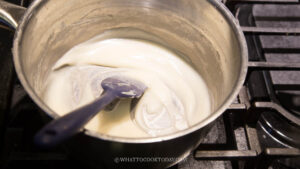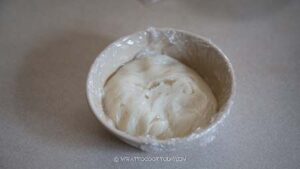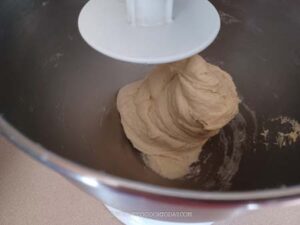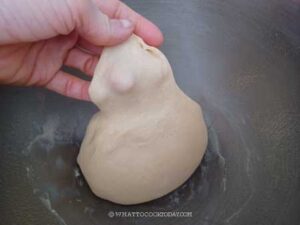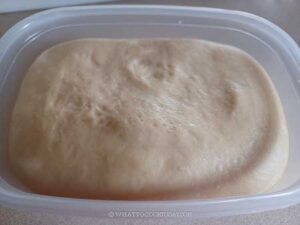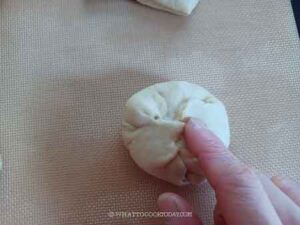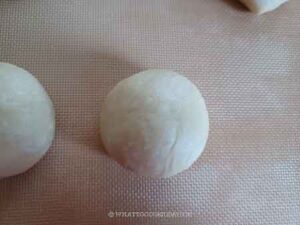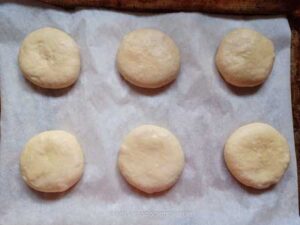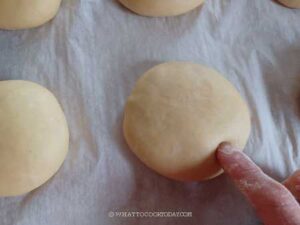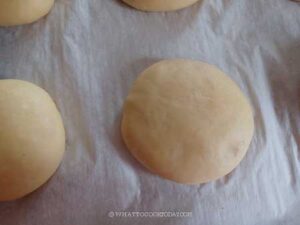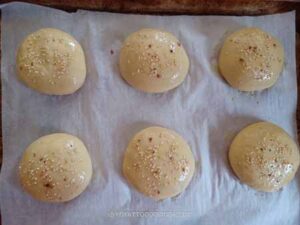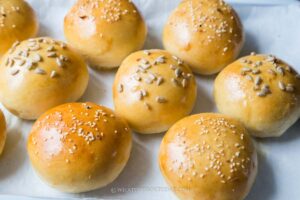This post may contain affiliate links. Please read our disclosure policy.
This tangzhong hamburger bun recipe creates a wonderfully soft and fluffy texture, making them the perfect base for your burgers. They stay soft so much longer too!

The tangzhong method originated from China. It became widely known through the work of Yvonne Chen, who introduced the method in her book “65°C Bread Doctor” in 2004. Tangzhong involves cooking a portion of the flour with liquid (usually water or milk) into a roux, which helps retain moisture and makes the bread softer and fluffier. This technique has become a global favorite for making various types of bread, including these hamburger buns! It does seem like an extra step, but it’s a very short step and it’s worth that little extra time if you ask me!
Why you’ll like this recipe
1. Use basic ingredients
You don’t need special ingredients to make these soft fluffy hamburger buns. You most likely already have all the ingredients in your pantry
2. They are soft and fluffy
They have a nice thin crisp crust but the inside is soft and fluffy
Ingredients and substitutions
1. Bread flour: Bread flour is recommended for its higher protein content, which gives the buns a chewy texture. If you only have all-purpose flour, you can substitute it, but the buns may be slightly less chewy.
2. Milk: Whole milk adds richness, but you can also use non-dairy milk like almond milk, unsweetened soy milk, etc.
3. Oil: Vegetable oil keeps the buns soft, but melted butter adds a richer flavor. Coconut oil is also a great dairy-free alternative, but it will add a subtle coconut flavor.
4. Instant yeast: Instant yeast is convenient as it can be mixed directly into the flour. If you only have active dry yeast, dissolve it in warm milk (about 100-110°F) with a pinch of sugar first to activate it before adding it to the flour.
5. Sugar: This is not a sweet dough. We just use a small amount of sugar, which add an overall nice taste
6. Salt: I use fine sea salt and I don’t recommend omitting salt because the taste will be bland. Salt also helps to strengthen the dough structure and control the rate of fermentation

Soft Fluffy Tangzhong Hamburger Bun
Ingredients
Tangzhong roux:
- 175 g whole milk
- 35 g bread flour (12.7% protein content)
Final dough:
- 370 g bread flour
- 135 g whole milk
- 20 g sugar
- 7 g instant yeast
- 30 g oil
- 8 g fine sea salt
Egg wash:
- 1 egg beaten
Topping: (optional)
- white sesame seeds or seeds of your choice or leave them out
Instructions
Prepare tangzhong:
- Combine the flour and milk in a non-stick pan or a saucepan. Use a whisk to stir to combine until you don't see any more lumps. Put on the stove and turn the heat to low-medium and keep stirring
- The mixture will start to thicken. Remember to keep stirring and don't crank up the heat. It will be a thick slurry consistency, about 2 minutes or so of cooking over low-medium heat

- remove from the stove and cover with a cling wrap, touching the surface of the tangzhong directly to prevent a "skin" from forming on the surface. Let it sit at room temperature until it cools down to at least lukewarm

Prepare the dough:
- Put all ingredients for the main dough in a bowl of a stand mixer fitted with a dough hook attachment. Add the tangzhong you prepare earlier
- Use a dough hook attachment to knead the dough until all the crumbly dough starts to come together into one mass, about 2-3 minutes. Continue to knead until the dough clears the side of the bowl and elastic. This may take about 5-8 more minutes kneading on medium speed for this to happen. It feels sticky to the touch and that's normal. Try not to add any more flour, the more flour you add, the drier the hamburger buns. If the dough feels too dry to you, add one tablespoon of water and knead again

- When you gently stretch a small amount of the dough thinly, it doesn't break easily. This shows proper gluten development

1st proofing:
- Place this dough in a lightly oiled large bowl, cover it with a clean and damp tea cloth or plastic wrap and let it rise at a warm place for about 1 hour. The dough will puff up and double in volume

Shaping:
- Prepare two large baking sheets lined with parchment paper.
- Fold the edges of the dough towards the center to deflate the dough. Divide the dough into 9 equal smaller-size dough. Cover with a cloth or cling wrap to prevent them from drying out
- Work with one dough at a time, round each dough up into a round ball


- Use your palm to flatten the dough to about 3-inch wide disc. Place it on a prepared baking sheet. Continue with the rest of the dough. Placed each shaped dough about 2-inches apart. I put 6 dough on one pan and another 3 on a different pan

2nd proofing:
- Lightly mist with some water and cover with a clean towel and place them at a warm place to let them proof again until the dough are noticeably puffy and light. when you gently push the dough with your finger, the dough bounces back slowly and leaves a bit of indentation.

- This is a sign that the dough is done proofing. It took about 45 minutes or so, depending on the temperature

- 15 minutes before the end of 2nd proofing, preheat the oven to 400 F (200 C) for conventional oven, 380 F (190 C) for convection oven. Position the oven racks, 3rd from the bottom and 3rd from the top
Baking:
- Brush the surface of the dough with some egg wash. Sprinkle with sesame seeds or seeds of your choice if you choose to use

- Place the baking sheets on the positioned racks. Bake for 10 minutes and then rotate the baking sheets, top to bottom, front to back. The buns bake evenly these way when you bake two pans at the same time. Bake for another 6 minutes or until the buns are nicely golden brown. The internal temperature should be 190 F (88 C)
Cool down:
- Remove them from the oven and transfer them to a cooling rack immediately to let them cool down. This is to prevent the bottom of the buns from getting soggy

RECOMMEDED TOOLS
*Nutrition facts are just estimates and calculated using online tools*

How to store and reheat
1. At Room Temperature: Store the buns in an airtight container or wrapped tightly in plastic wrap for up to 3 days. The tangzhong method helps keep them soft, but if they begin to dry out, you can refresh them by microwaving for 10-15 seconds.
2. Freezing: To freeze, wrap each bun individually in plastic wrap and place them in a freezer-safe bag or container. They can be frozen for up to 2 months. To use, thaw at room temperature or heat in a 350°F oven for about 10 minutes.
3. Reheating: If the buns become stale, wrap them in foil and bake for 5-10 minutes to soften them again.

